MCACN 2021 Part II: Back for more

Considering this is the second (and final) installment covering the 2021 Muscle Cars and Corvette Nationals, it would seem appropriate to continue with the Day 2 display. That means plenty of cars featuring period modifications from back in the day. As you’ll see, the collection of cars we selected appears to be Chevy-heavy, but even the most jaded Brand Xer has to admit it’s the presentation, and not the brand, that makes Day 2 cars so special.

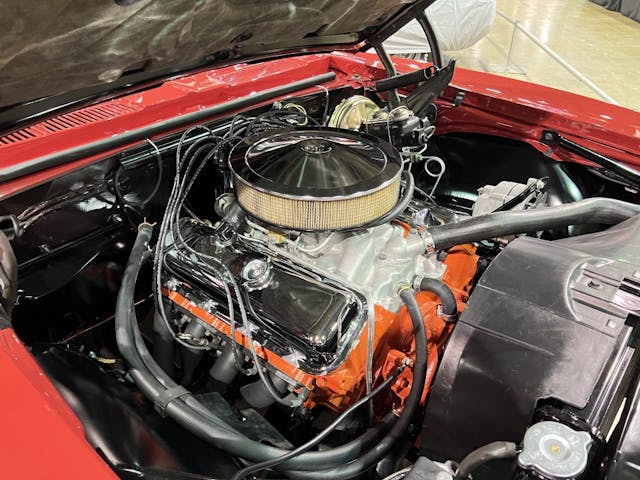
Here’s the very first 1967 Yenko Camaro, looking great in Rally Sport trim. Though it may not look Day 2 in many ways—no mag wheels, fancy tires, rake, etc.—it’s an example how some companies and dealers were clued in on a packaged supercar. Of course, being a 1967 Yenko, it has a transplanted 427.


So perhaps this 1967 Camaro Z28 is more in the vein you were expecting. The Z28 (it didn’t officially receive the “/” till mid-year 1968) was somewhat obscure in the Camaro’s debut year, with 602 built, but it was the Camaro for the enthusiast who fancied himself a road racer. Note the cowl plenum, which was an available option from the factory, as were the headers.
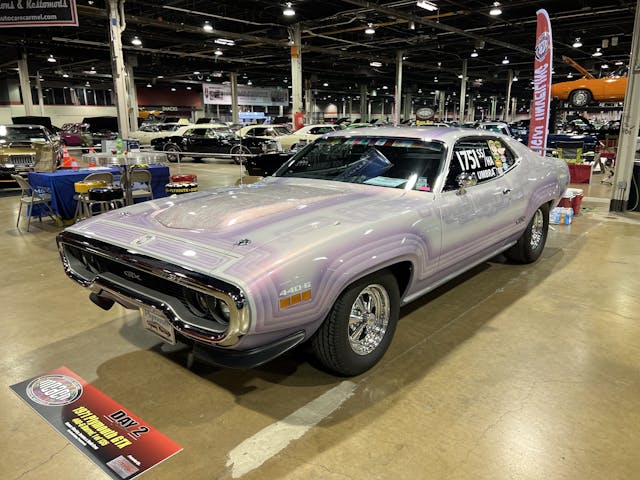
I’m not totally sure about the modifications on the 440 Six-Barrel under the hood here, but you can see this 1971 Plymouth GTX features a spectacular “World of Wheels”-like paint job nicely preserved from back in the day. The GTX had been redesigned for 1971, the last hurrah before compression was lowered across the board.

This 1970 Buick GS, known as 3 is the Charm, reflects a different period, as in 1977 it was painted and customized and, several years later, was a World of Wheels show winner. Yes, it features rolled and pleated Naugahyde, Lakewood ladder bars, and such names as Crower, Hooker, Poston, and TA Performance under the hood.

You may have heard of Baldwin-Motion before, but some people don’t realize it was a venture between a dealer, Baldwin Chevrolet, and Motion Performance. Just like the Yenko above was subtle, B-M cars were in your face, and when it came to its Phase III series, chances they were out of your sight because they were guaranteed to run 11s. Most of them were big-blocks, but this 1972 Camaro is a Z/28 so that means it started with an LT-1 350 and Motion took over from there.

MCACN gives individuals and restoration shops an opportunity to debut freshly restored cars with the Official Unveiling displays scattered throughout the convention center. That, combined with some new finds that also making their debut at the show, are what we will see next.

A perfect example of the latter is this 1970 Oldsmobile F85 with the W31 performance package. Only 207 were built, but what makes this one truly exceptional is that the original owner special-ordered it in a Cadillac color called Nottingham Green Firemist. Firemist pigments were originally developed by Engelhard Industries and exhibit “an intense sparkling and depth in a wide range of interference effects” to convey a “brilliant, star-like glitter.” Stripes were originally black but were enhanced at the dealership. Does it get better? Sure—it has an aluminum W27 rear.

The Coronet R/T was introduced in 1967 to be Dodge’s “image car” to compete with the GTO. However, with the 1968 redesign, this model was overshadowed by the spectacular Charger R/T. As such, cars like this Hemi car tend to get lost in the shuffle.

Speaking of Coronet R/Ts, here’s the 1969 version of that vehicle, but this one is a Hemi ragtop. You may notice the all-new Ramcharger air induction scoops that were available that year (and standard with the Hemi). Out of the 10 built to U.S. spec, only four had the four-speed.

A 1969 Camaro Z/28 is far from a rare car, yet some examples stand out more than others. It seems there’s this “thing” with a special-order color generically called “Carolina Blue” (think of the school colors for UNC) that has dotted the Chevrolet landscape in the twilight of the era. This Z/28 is one of those special cars.

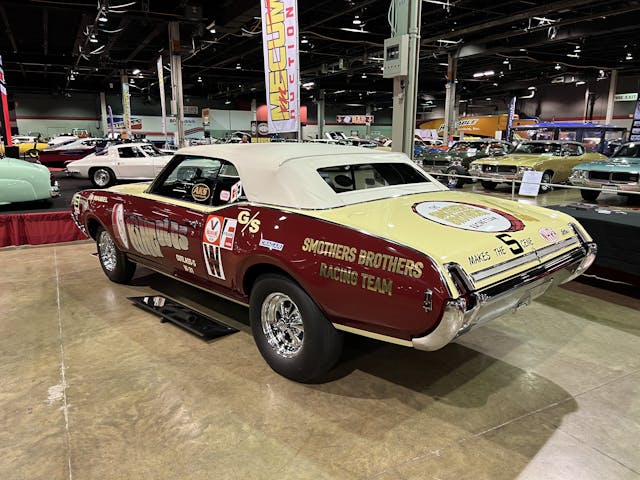
You may remember that comedian and auto enthusiast Dick Smothers joined forced with Oldsmobile to run the Smothers Brothers racing team. One of the actual race cars, originally campaigned by Florida-based King Olds and driven by Jim Waibel, has been restored to as-raced condition. If that alone is not cool enough, get this: the 1969 Cutlass S convertible is one of 26 built with the W31 package.

Everyone knows about the 1970 Buick GSX, which were available in Saturn Yellow or Apollo White. The package continued into 1971, now available in six colors, though only 124 people were interested in one. Styling was slightly tweaked, especially the grille (including matching scoop) and taillights, so here you can compare this Stratomist Blue one with the iconic ’70 version.

Dodge offered some bright colors for the Challenger in 1970, but there also were colors on the palette that would be more at home on a four-door Dart. “BL1” Beige is one of those colors, and approximately 41 Americans ordered a Challenger R/T in this totally drab color. How many were Hemis? No one knows, but this stripe-delete example is nicely complemented with a tan interior.

Hemi ’Cudas came standard with the Shaker hood scoop, but it was an option for Dodge Challenger R/Ts. It seems Six Packs are the most common, with Hemis running a distant second. But finding one on a 440 Magnum seems to be a needle-in-a-haystack proposition, with only two documented examples known to exist. Late availability in the model year seems to be the culprit.

The Mustang has always played the role of once and future King of the pony car world (and, arguably, the 1960s as a whole). However, by 1970, production had fallen drastically as the sporty and performance market was changing due to shifting demographics (with a bit of insurance surcharges thrown in). Nonetheless, cars like this Cobra Jet-equipped 1970 Mach 1 carried the Ford performance banner with aplomb.
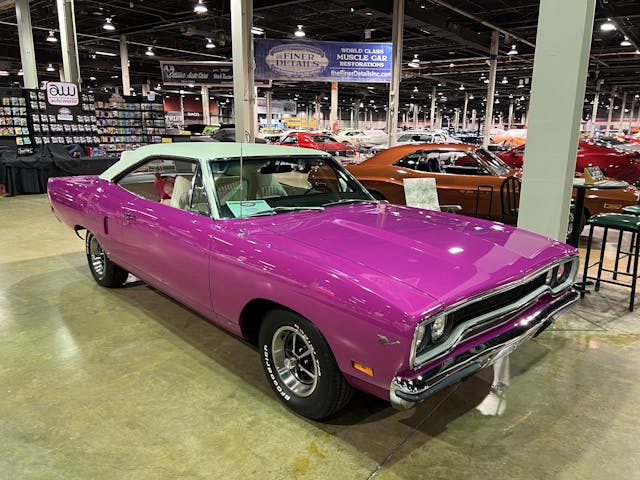
“FM3” Moulin Rouge (Dodge called it Panther Pink) was a mid-year hue that was not very popular, but today it is quite popular with the Mopar cognoscenti. For this 1970 Road Runner hardtop, approximately 47 U.S.-spec cars were built in this color. Note the white vinyl top and lack of stripes (only the trunk stripe was standard on hardtops), which nicely set this one off.
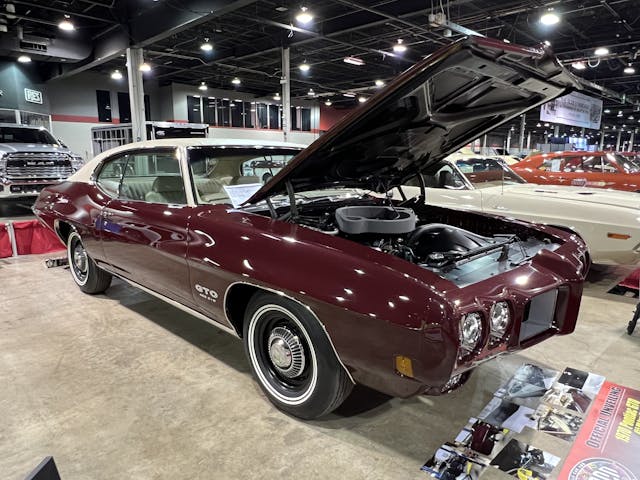
Ram Air was optional only for the new-for-1970 455 on the GTO. But what is most noticeable about this Goat is the dual-stripe white walls and poverty caps. When was the last time you saw one like that? Add the Burgundy paint (only 1246 built) and contrasting vinyl top and you have a stand-out.

Performance may have been dying a slow death starting in 1971, but this 1973 Road Runner tried to keep the flame alive. When you ordered the 440 engine, all Road Runners received GTX badges as a nod to its stablemate that last appeared in 1971. Approximately 749 cars were built with the 440, and this one has a sunroof to boot.
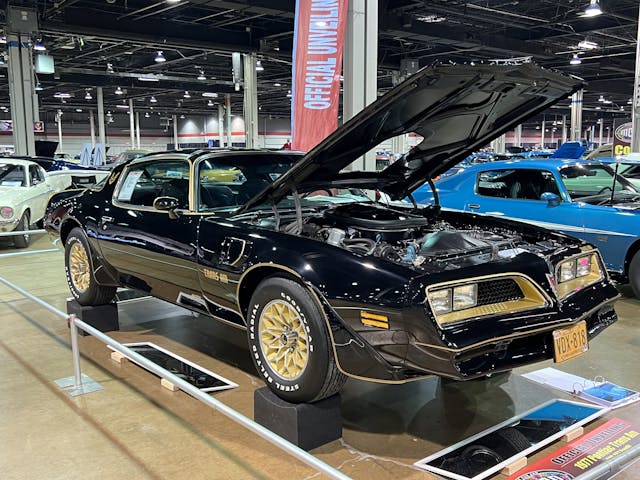
By 1977 performance was a thing from the past, but Pontiac’s perseverance and a certain Hollywood movie helped keep the flame alive. These “Bandit” Trans Ams started to get pricey a few years ago, so now it’s possible you will be seeing more and more of them restored to the level of this example.
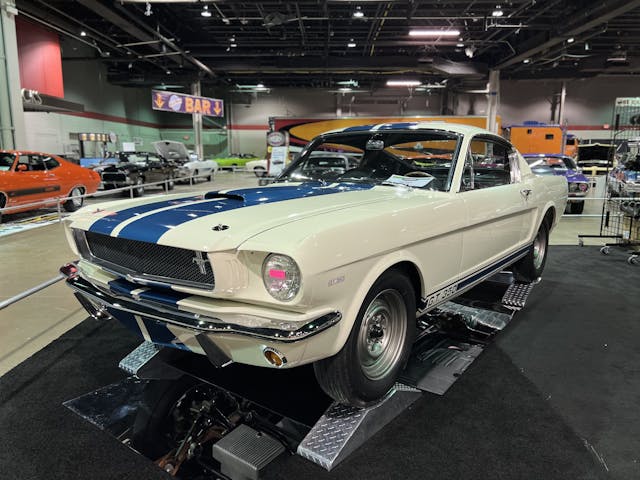
Moving on, how about this 1965 Shelby GT350? The first year of the Shelby Mustang, and the most pure iteration of the series. Though number 003, it’s considered the first Shelby Mustang because car 001 was a “street prototype” used for promotional purposes, and then the Venice factory mistakenly skipped number 002. This car features several transitional items that were considered for production but didn’t last, like “GT350” decals on the front fenders. Plus, it was converted by the factory to R-model racing configuration and raced as such for several decades. Among 1965s, perhaps none have the provenance of this one.

A car that had lots of folks chattering was this 1965 Chevelle 300. You may be familiar with the Z16 Malibu SS 396, of which 201 were built with a unique L37-spec big-block putting out 375 horses, but this lowly black Chevelle was a Central Office Production Order (COPO) vehicle ordered with the 425-horse L78 that was available on the Corvette and big cars. Likely it’s the only one built.
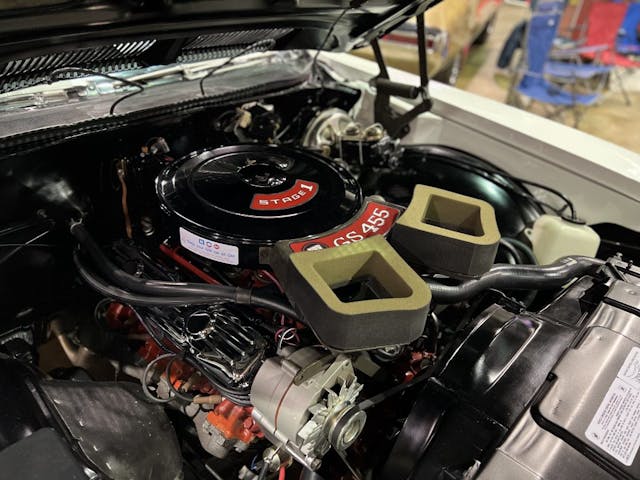
Walking on, you’ll find an assemblage of Buick GSs, mainly 1970–71. There are a few standouts here worthy of highlighting.

To the casual observer, this 1970 Stage 1 is maroon, but it’s really a special-order color normally reserved for the Riviera called Titian Red. It has a hint of rose that gives it a feminine quality that belies the power of its 455.
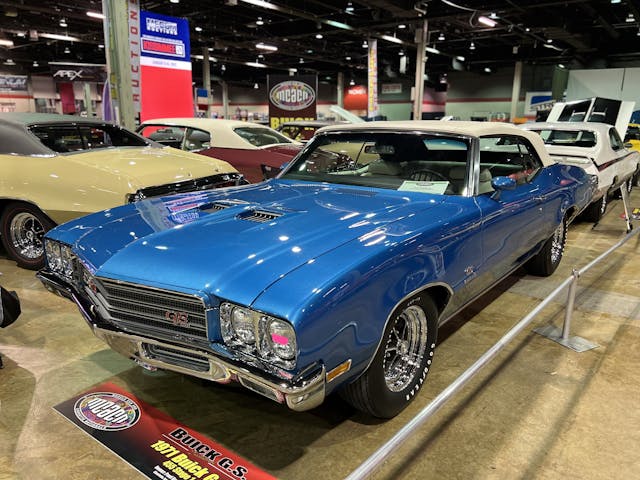
The Gran Sport series was reshuffled a bit for 1971, now encompassing three engines (versus the 350-based GS and GS 455 for 1970). As such, this was the first time for a 350-based GS convertible. However, the Stage 1 was still available, of which 81 were built like this one.

Another 1971, this Stage 1 is painted in Burnished Cinnamon, a color that was initially introduced for both the 1970 Camaro and Firebird as Classic Copper and Castilian Bronze, respectively. It was instituted across the board for 1971.
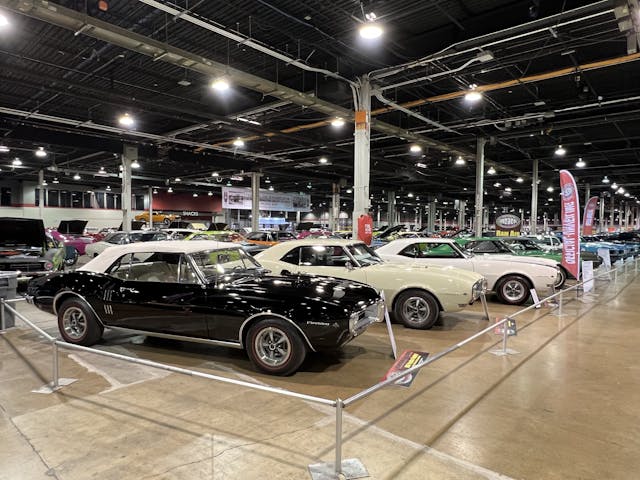
Next up is the Ram Air Invitational, a Pontiac Firebird display that contains prime examples of top Pontiac pony cars. Only 65 1967 Firebird 400s were built with the 325-horsepower Ram Air engine, and it is believed only eight were convertibles. Can you believe the luck in such a rare car was ordered in this color combination?
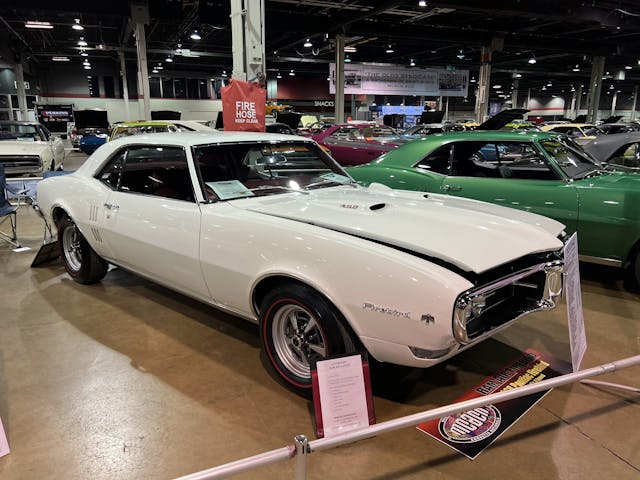
That engine was continued into 1968, generally called “Ram Air I” by Pontiac folks. Only 321 hardtop and convertible four-speeds were built, though this one marches to a different beat thanks to having its original engine, transmission, and differential, and its unusual mix of options including headrests, fold-down rear seat, rear defogger, exhaust splitters, and no radio.

In April 1968, Pontiac introduced a replacement for the Ram Air engine and called it Ram Air II. Rated at 340 horsepower, the RAII featured Pontiac’s first use of the vaunted round-port heads. Only 110 were built, but this one is even sweeter due to its special-order Chevy Rallye Green paint.

So the Ram Air II had a brief existence from April till the end of the model year, but Pontiac was already working on improvements for 1969. That replacement was called the Ram Air IV—not because it was fourth in line but because it initially was planned to have four intakes. This Midnight Green example is one of 17 built.

Like the Judge was to the GTO, the Trans Am was to the Firebird 400, both introduced in the new 1969 calendar year. While the Judge was a cultural put-on, the Trans Am seemingly had legs and would prove to last into the millennium. The car pictured above is the very first Trans Am of the 697 built.
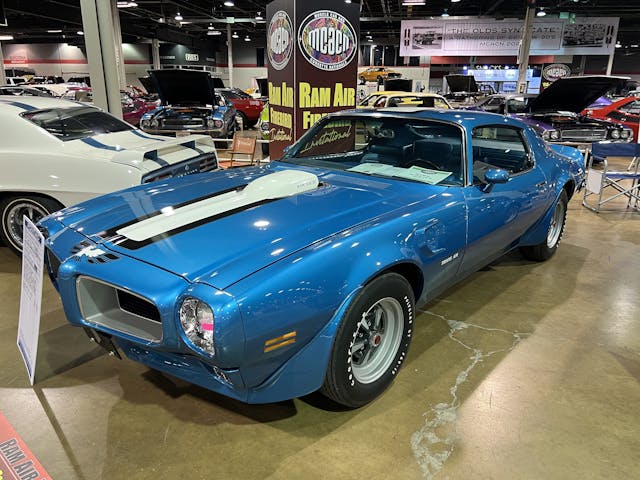
A year later, Pontiac introduced a redesigned Firebird. The Trans Am was beefed up, going from a quasi-poseur to an honest-to-goodness road car. Thanks to some engine programs that didn’t materialize (like the Ram Air IV Super Duty and the Ram Air V), Pontiac was late to introduce a hot engine for the Trans Am and belatedly released the “regular” Ram Air IV engine. Only 88 of those were built like this one.

So if you’re not a Pontiac guy or gal, you’ve learned that the round-port Ram Air II was followed by the Ram Air IV. The 455 HO from 1971-72 continued the round-port goodness, which culminated in the Super Duty 455 of 1973–74. Only 232 Trans Ams were built with this engine, with 72 being four-speeds. Only three colors were available: Buccaneer Red, Cameo White, and Brewster Green. The latter—a good green, for once!—is the most desirable among Pontiac aficionados.



Nearby you’ll find one of the largest displays at MCACN: the 1966-67 W30 Invitational organized by the “W30 Syndicate.” You’ve seen some of the evergreen 1970s in Part I of Hagerty’s MCACN coverage, but the genesis of Oldsmobile’s force-air hi-po package was in 1966. Oldsmobile already had made a name for itself with the 4-4-2 thanks to competitive horsepower and a rear-sway bar that made it the best handler of the crop of muscle cars. The L69 option added tri-carbs with 360 horsepower on tap.
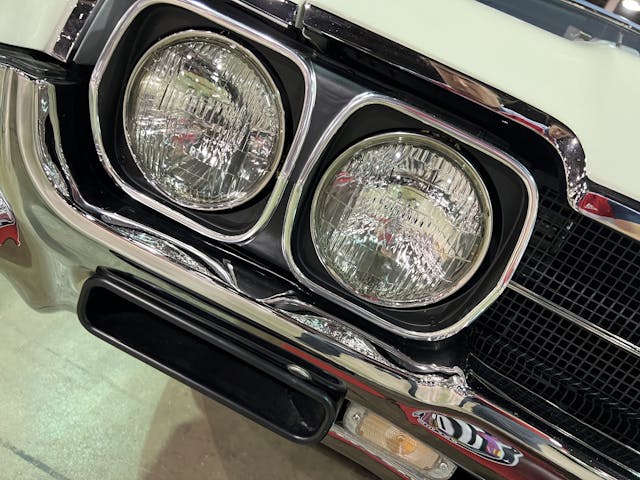
But the W30 package added a hotter camshaft, better valvetrain, mandatory four-speed and 4.33 gears, and a nifty air-induction system that consisted of tubes running from a unique air cleaner to the lower-bumper cavities. Only 54 were built by the factory, though a handful of kits were available at dealership parts counters to allow owners to upgrade theirs. NHRA C/Stock was the aim, and Oldsmobile won that championship.

What’s interesting about the 4-4-2 package in 1966 was that it was available on the F85 Club Coupe (with B-pillar), F85 Deluxe Holiday (hardtop) coupe, Cutlass Sports Coupe (with B-pillar), Cutlass Holiday Coupe, and Cutlass Convertible. The W30 package was available on all but the latter, with this interesting two-tone example being the former.
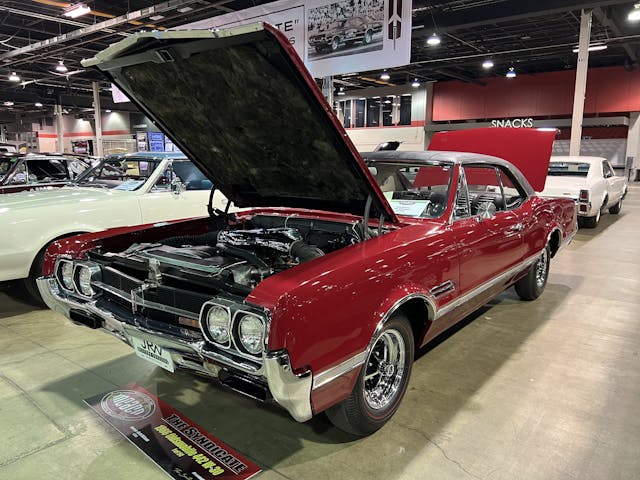
Compare that to this Cutlass 4-4-2 Holiday. While it too could come with poverty caps and few options, it would be distinguished by a fancier interior than the basic F85-based 4-4-2 plus some trim, the most noticeable running along the sides. This one with vinyl top and Super Stock I wheels is about as fancy as they come.

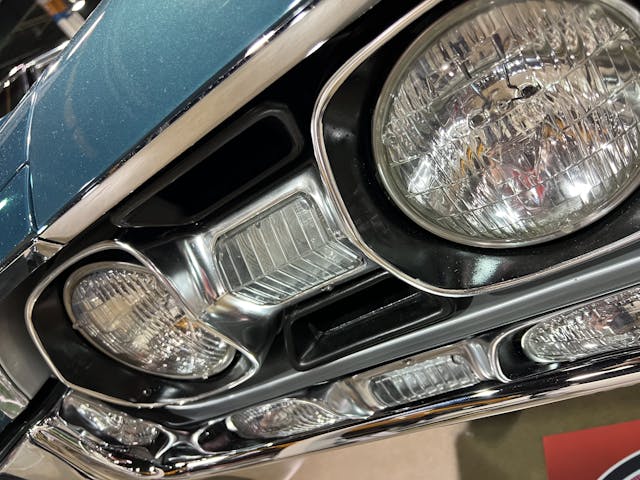
In 1967, Oldsmobile moved the 4-4-2 package upmarket, now based on the Cutlass Supreme series. General Motors killed tri-carbs except for the Corvette, so the W30 package made do with the new Rochester QuadraJet. New details included scoops surrounding the parking lights and what would become a W30 trademark: red plastic front fender wells. Just over 500 were built, but documentation is key in proving a real one. Note the white painted top and American Racing 200S mags.


Chesrown Oldsmobile in Columbus was arguably the most famous campaigner of the Lansing rockets. Ron Garey was the racer who made a name for the dealership, and Tweed Vorhees was his teammate. Today. Tweed shares his experience, knowledge, and history with Olds enthusiasts, including his Chesrown replica. However, Brainbeau Oldsmobile out of Massachusetts was the dealership that won the NHRA championship in 1966.
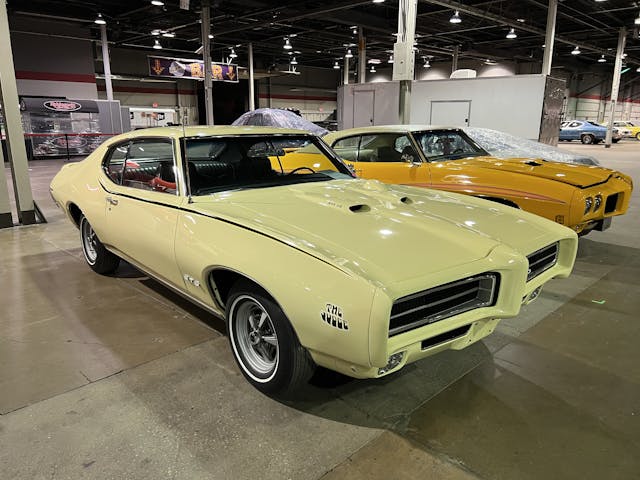

Let’s move on to the Judge’s Chambers. While small, there were examples of the GTO Judge that stood out from what you normally may see, such as this Mayfair Maize 1969. Compare the stripes to the Starlight Black Judge—Pontiac had several stripe colors to match a particular paint.

The stripe thing was true for 1970 too. In fact, if you ordered a Polar White Judge, you received blue/yellow/red stripes. But if you ordered the WT7 option on top of the Judge package, which included a flat black spoiler, the stripes were superseded by yellow/black/red stripes. Only 51 Judges were built with the WT7 option.
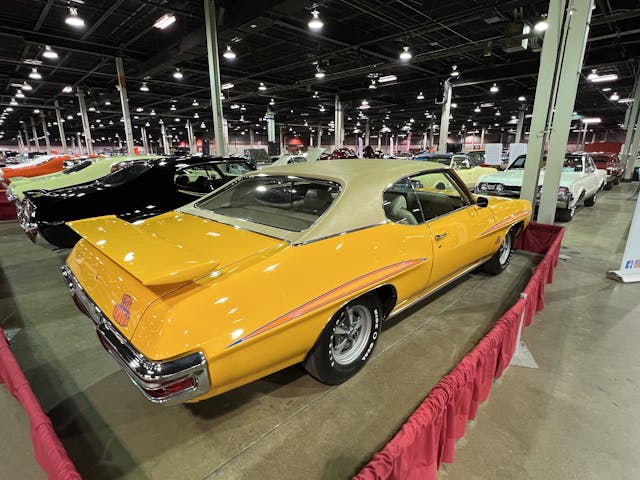
When the 1970 model year began, Pontiac determined that a WT7-equipped Judge would be a signature configuration, and that’s what you’d find in early ads. But white doesn’t necessarily scream “look at me!” so, sometime after production, Pontiac introduced Orbit Orange, which came equipped with orange/blue/pink stripes. This Ram Air IV example also features an unusual Sandalwood vinyl top.
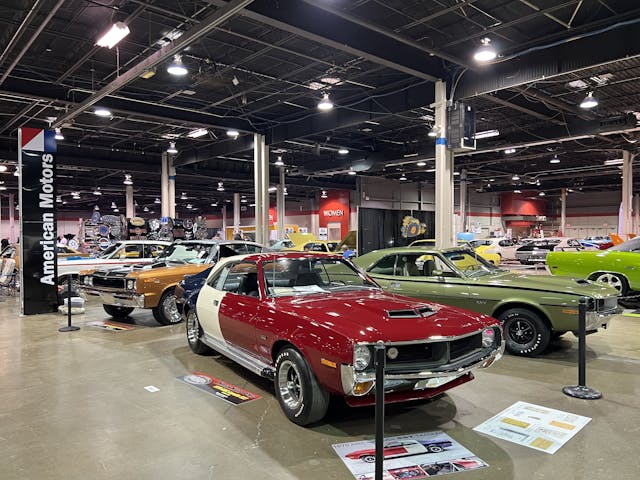
Now how about some AMCs? The local American Motors club has had some spectacular displays in the past, chock full of old dealer items, literature, and models. Possible winner of “Car with Neatest Paint Job” may go to the Trans-Am Javelin, a red-white-blue pony car that was only available with a 390 4-speed and unique spoiler. Only 100 were built.
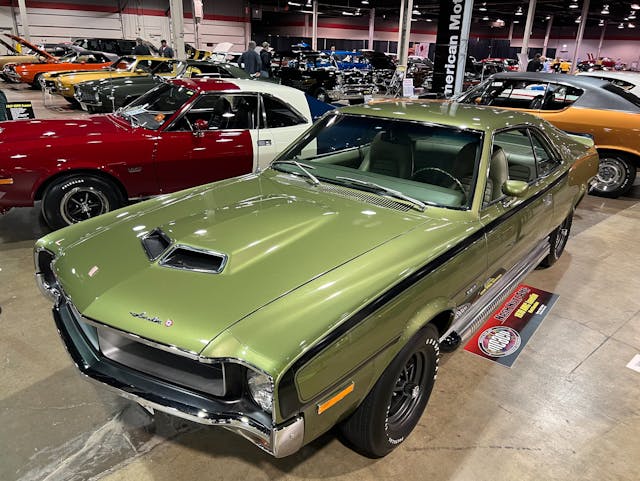
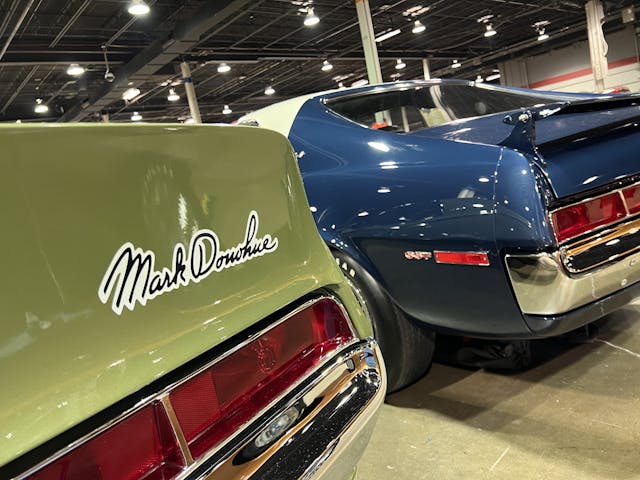
Interestingly, the T-A Javelin was not the homologation special for the Trans-Am circuit—that honor went to the 1970 Mark Donohue Javelin. Prevailing wisdom says they all were SSTs with the Go Pack which included either 360 or 390 with ram air, but there are some AMC experts who feel even the base Javelin could receive the Donohue treatment. Other equipment included front spoiler and C-stripes but the defining item for this car was its rear spoiler that was designed by Mark Donohue himself. Note how it differs compared to the Trans-Am Javelin.

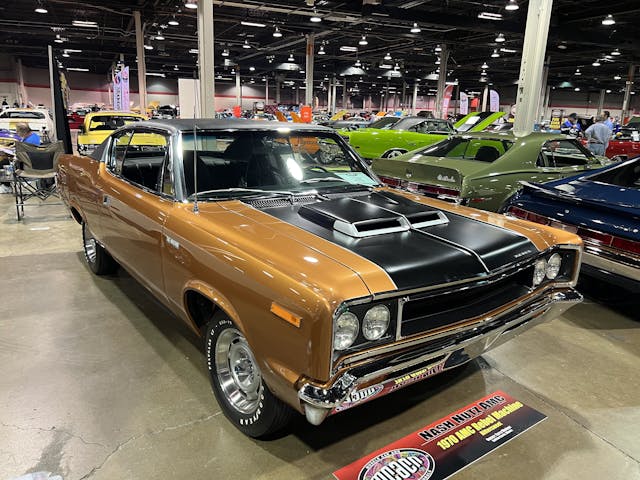
American Motors started getting serious with high-performance in 1967 with the introduction of the 343. The Javelin and AMX followed in 1968, but for some reason AMC didn’t produce a “proper” muscle car until the 1970 Rebel Machine. All of them came with a 340-horsepower 390 with ram air, and the bulk were produced in this nifty (what else?) red-white-blue paint scheme. However, they were available in other colors like Bittersweet Orange.

The Javelin was redesigned in 1971, and the AMX was demoted from two-seater specialty car to a performance model upgrade for the Javelin. That style was carried through 1974 and—get this—sales were stronger in those final two years. There still were neat options like cowl-air carburetor induction system, as evidenced by this 1973 Javelin AMX in Copper Tan metallic with cinnamon vinyl top and tan Domino cloth interior.


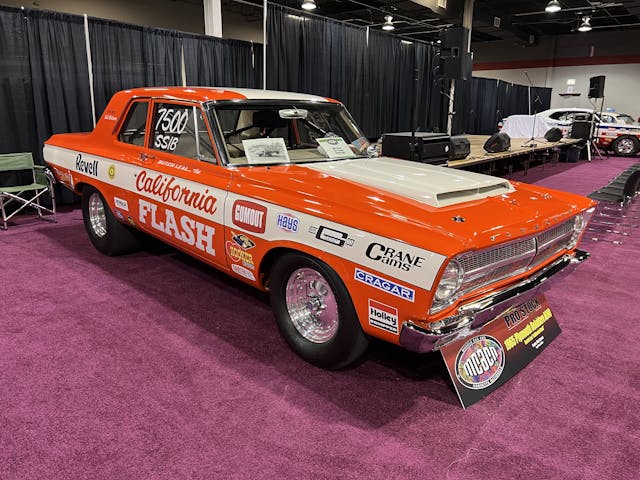
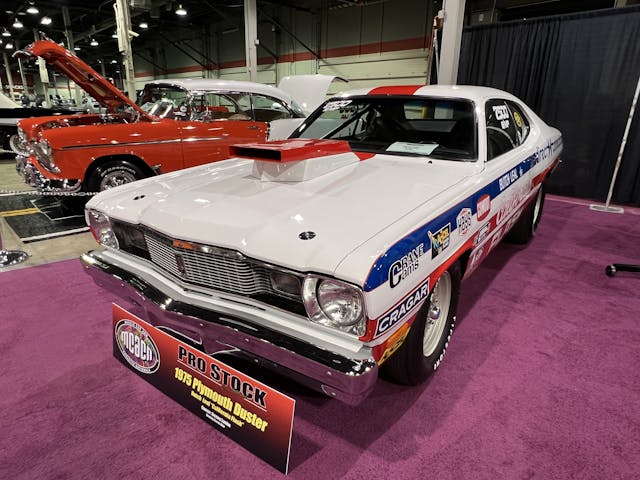
If Pro Stock or the 426 Hemi is your thing, you will dig the Motown Missile and California Flash race cars that reflect glory days gone by. The Motown Missiles present are the 1971 Dodge Challenger and its 1974 Plymouth Duster stablemate. But if your tastes run more towards factory racer, then Butch Leal’s California Flash 1965 Plymouth “A990” Belvedere should check the right boxes. Of course, Pro Stock evolved, as did Butch, as evidenced by his 1975 Plymouth Duster.

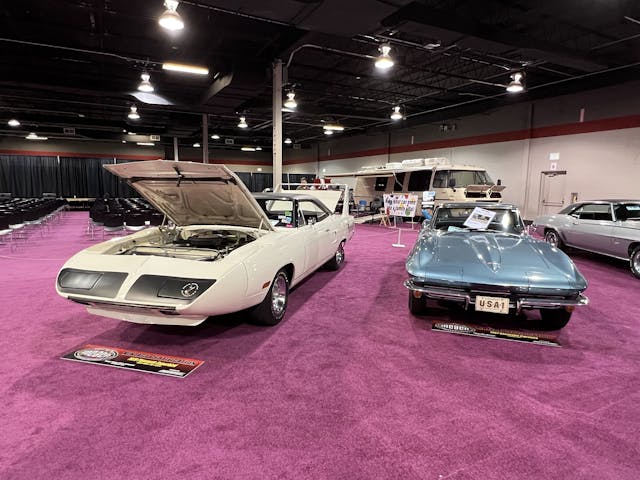
Now it’s time for Vintage Certification, the place to bring your car if it’s a survivor (and we don’t mean like in the way people on eBay abuse the word). The MCACN website describes it as a “…program [that] provides status, recognition, provenance and appreciation to unrestored vehicles. The certification team provides each owner with a detailed listing of our findings in a comprehensive report. Our goal is to uncover new information, share it with you and act as a repository for factory standards and processes.” If original paint and chalk marks make your body tingle, this section is for you.
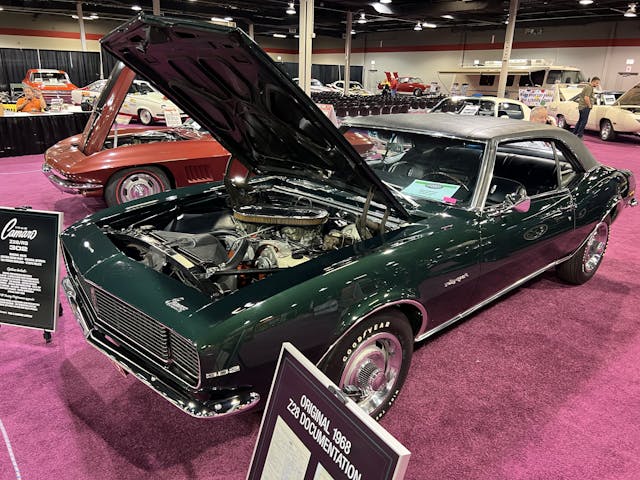


Here’s a 1968 Camaro Z28 that is trying to earn its stripes. Every Z should come with twin band-aid stripes front and rear, but this one is a stripe-delete car, which is quite uncommon. It’s also painted British Green, which was originally a Corvette color introduced in January. Also note the 302 badges before the Z/28 badges were phased in. It also has dealer-installed 2×4 intake and rear disc brakes, both dealer-installed options. Now go find a more spectacular Camaro!
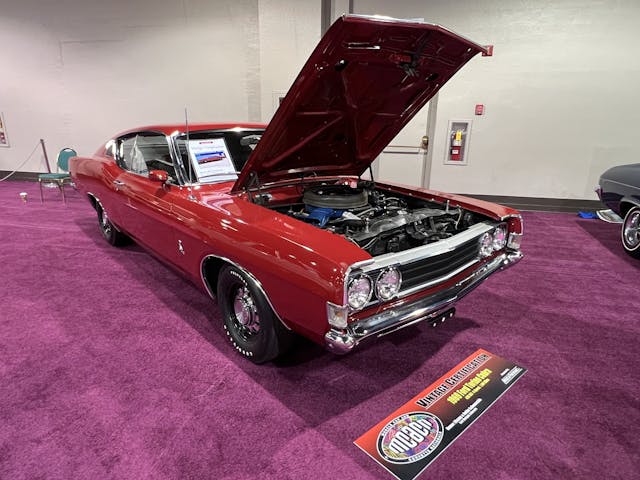
This 1969 Ford Cobra has barely over a thousand miles. The Cobra model trips people up—even Ford folks—because it was called the Torino Cobra in 1970–71, but the 1969 Cobra was based on the cheaper Fairlane. To add to the confusion, Ford produced several ads touting its racing success by calling it a Torino Cobra. Why? One theory would suggest the Torino was Ford’s new top mid-size model and the Fairlane was slowly being phased out, but it’s anyone’s guess. Eventually, the Cobra-based Torino Talladega took over NASCAR duties from the Cobra.
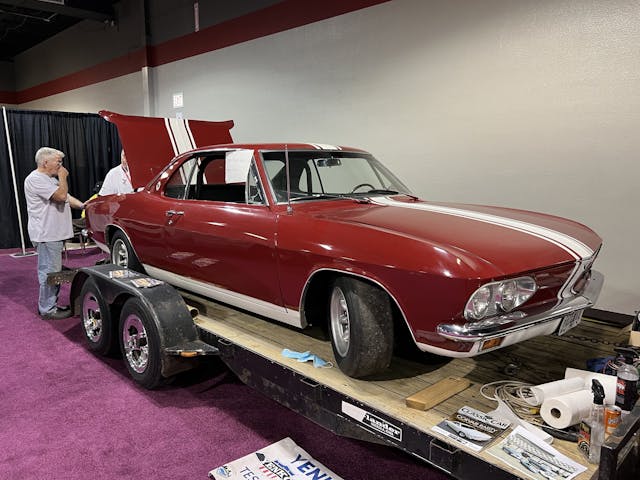
While a six-cylinder is more SCCA racer than muscle car, this is a Yenko Stinger, the first of Don Yenko’s concoctions. Yenko ordered 102 1966 Corvair Corsas via COPO order (his experience with this led the way for the 1969 Camaro with 427s). They came with special suspension, Posi 3.55 or 3.89 gears, four-speed manual, special steering equipment, independent brake unit, and Cadillac dual master cylinder. Several stages of tune were available, from 160 to 250 horsepower. Most were white and blue, American racing colors, but this was the only red one built.

Both these look like basic Chevelle SS 396s. The 1970 on the left is the standard configuration, without stripes or Cowl Induction. And note the wheel covers of the Mountain Green 1967, which is something you don’t see too often. If you took a peek inside, you’d notice it also features the standard three-speed transmission on the floor.

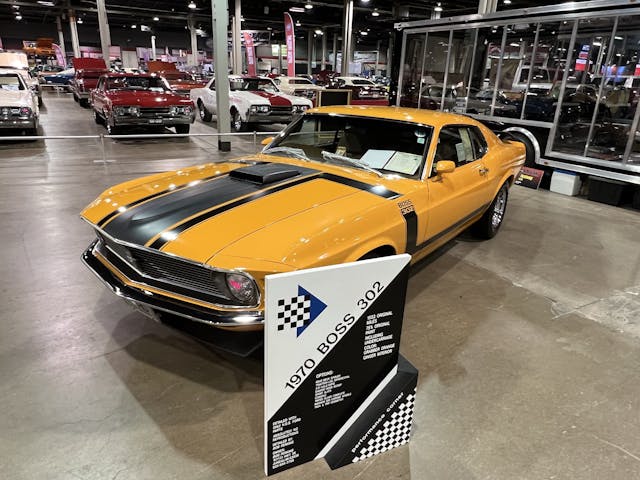

Another fancy pants judged class was Pinnacle Certification, “reserved for the absolute best of the best in the Shelby and Ford Mustang world.” All submissions must have previously won their gold status in several competitions before being able to qualify. The usual suspects, like Boss Mustangs, were there, but a nice 1971 Mach 1 with the 429 Cobra Jet and ram air.
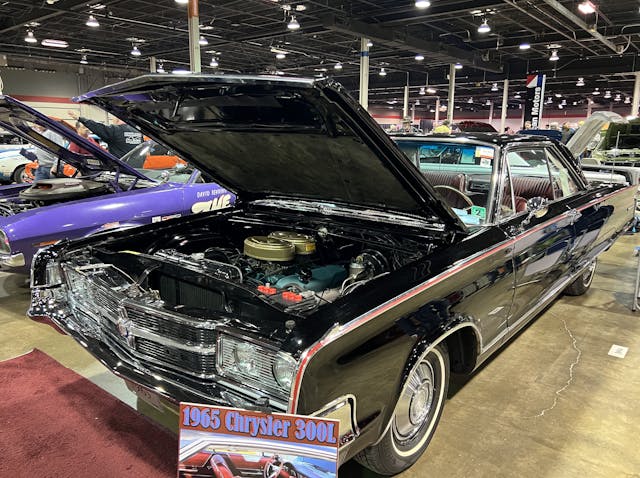
Mopars have always had a strong presence at MCACN. There also were a number of Mopars not part of any display in particular, and some of them were quite outstanding unto themselves, like this 1965 Chrysler 300-L. As the swan song of the 300-Letter series, the L only came in one configuration: 360-horsepower 413. This hardtop is one of 76 U.S.-spec hardtops built with a four-speed.
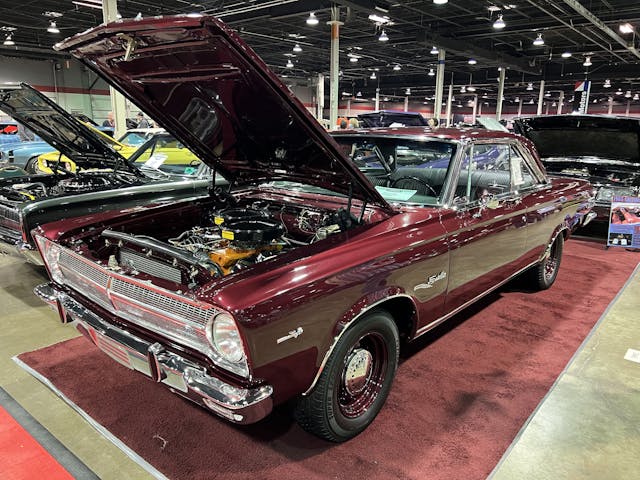
Also from the same year, this Satellite is notable for several reasons: the first year the B-body played the role of mid-size series, and the second and final year for the 426-S engine. Sometimes known as the Street Wedge, the 365-horsepower 426 was the forerunner of the 440 Super Commando that appeared several years later in the 1967 GTX. It was a worthy competitor to the GTO, 4-4-2, and Gran Sport, but it lacked the image that ended up being necessary for mass appeal.

This 1966 Charger played the dual role of fancy fastback with personal-luxury pretensions and muscle car with the new-for-1966 426 Street Hemi. Contemporary fastback styling, high-zoot interior (with a dose of utility), hidden headlights, and King Kong under the hood? A landmark car in a post-Mustang and GTO world.
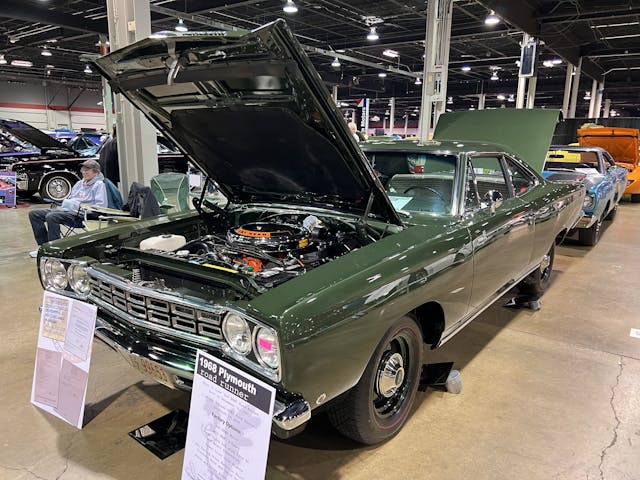
So maybe Plymouth took too long to come up with an answer to the GTO, but it reconciled its misgivings thanks to marketing. Austere performance was nothing new, but the Road Runner was different: its image was strong, and hit the sweet spot for kids bagging groceries. Adults dug it too.
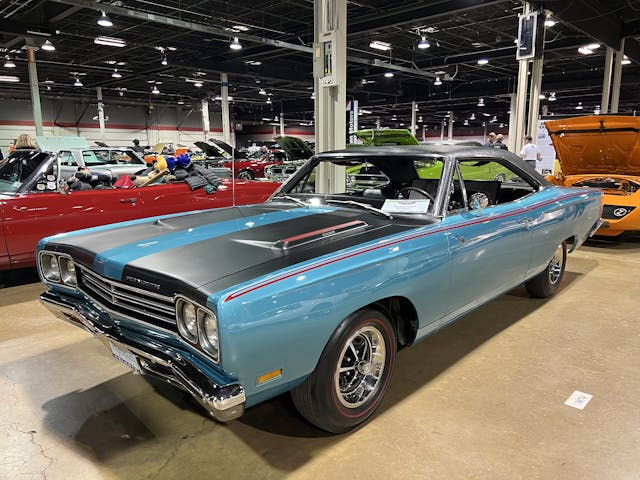
A year later, tons of refinement without losing its soul. The Road Runner featured several striping options, some able to be used in conjunction with each other, as you can see here. But what’s truly neat about this 1969 Road Runner is the “Q5” Seafoam Turquoise with red “V6R” tapered sport stripes.
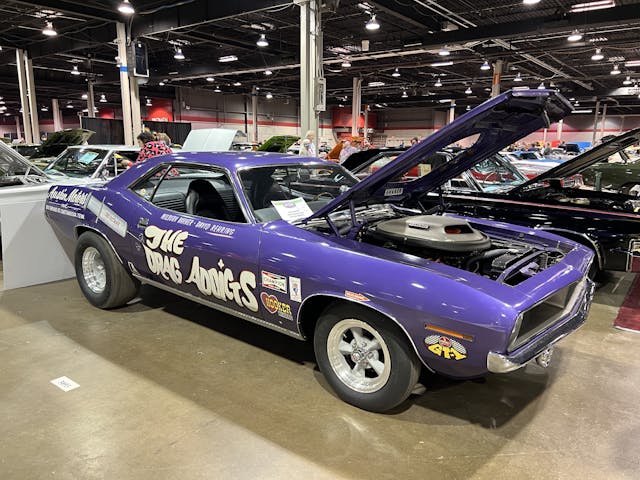
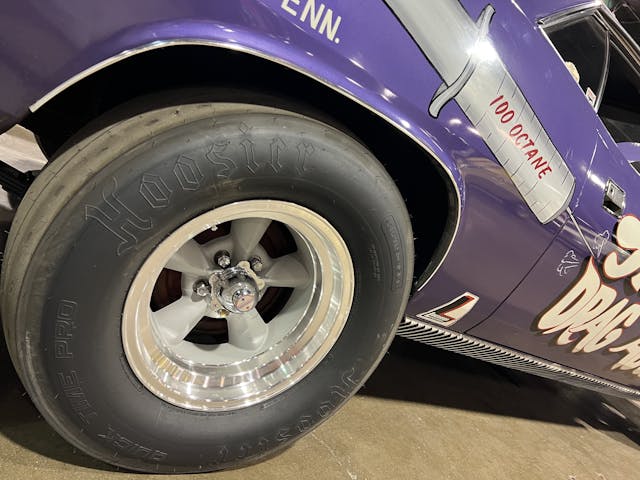

This 1970 ’Cuda (originally a 440-6 car) was parked in 1973 with 149 miles. It acquired a Hemi from a 1967 Hemi GTX convertible (!) not long into its drag history. Both cars were rescued several years ago, but the ‘Cuda here is in as-raced condition.

Opie Stark bought this 440-6 1970 GTX 18 years ago. He found a registration form from 1976 in the ashtray, and his wife wrote a letter to the name on that document. Turns out he was the original owner, and both he and the car were reunited at MCACN. Opie and his family, including wife, daughter, and brothers, completed the restoration.

Right when Pontiac takes all the credit for being THE performance brand in the early 1960s, here was Studebaker setting speed record after speed record. And while the 11th-hour Hail Mary of the Avanti’s creation fell short of saving the South Bend manufacturer, it was not for naught.

Only nine Avantis were built with the R3 engine (304.5 cid/335 horsepower), but they were all 1964s. This 1963 is a prototype known as “Car #8” and is one of the Bonneville test cars used to set records at the 1963 Speed Week, though (identical) Car #9 is the one that set a production land speed record at 170.8 mph and #8 was the backup.

Here’s a stock 1963 Avanti painted Avanti Gray. It’s equipped with the R2 engine, which means it has a supercharged 289 putting out 289 horsepower. Out of the 4647 Avantis built for the 1963–64 model year, 1842 were supercharged.
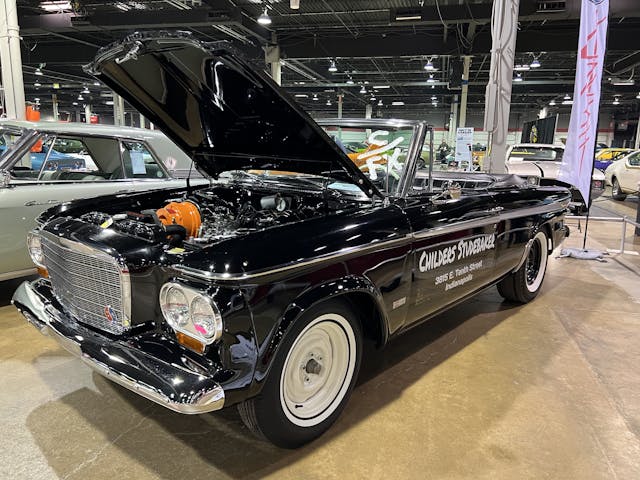
Hot engines were not limited to the Avanti. This 1963 Lark Daytona convertible has the R2 engine, but it’s also one of five convertibles equipped with the Super Lark package, which included the R2, Borg-Warner T-10 four-speed, bucket seats, 160 mph speedo and 6000-rpm tach, front disc brakes, HD springs and shocks, rear stabilizer bar and radius rods, and HD Twin-Traction rear axle. A salesman at an Indy dealership raced this car in C/FX and C/Gas Supercharged through 1964.
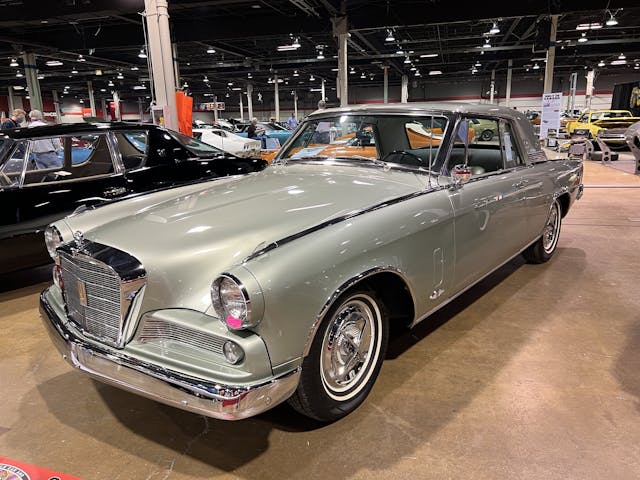
Nineteen sixty-four was the last year for the GT Hawk, Studebaker’s personal-luxury car. Originally sold in California (and retaining its original sheetmetal), this GT Hawk is one of 70 with the R2 engine, and the only one of those to be painted in Horizon Green. Powershift three-speed automatic paired with a Dana 44 with 3.54 gears complete the package.

For several years, the Pure Stock Musclecar Drag Race folks have had a display at MCACN for marketing purposes, as there’s always someone out there with an itchy trigger finger who wants to see what his or her can do.
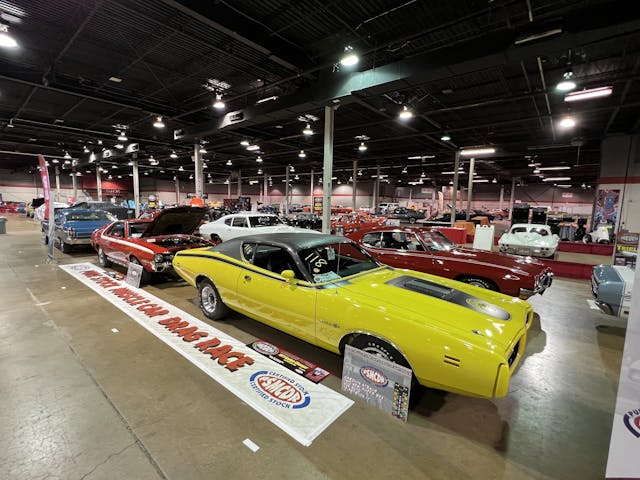
But it’s the quality of the cars that are the highlight. Every one of these cars would be at home at MCACN, race or no race. You will find something for lovers of any brand . . . and, yes, that’s an AMC in the back. (We heard you, commenters!) Yet the race is not about fast times as much as how fast an ET can you pull, as there’s skill and dexterity in learning how to tune your car for improved times.
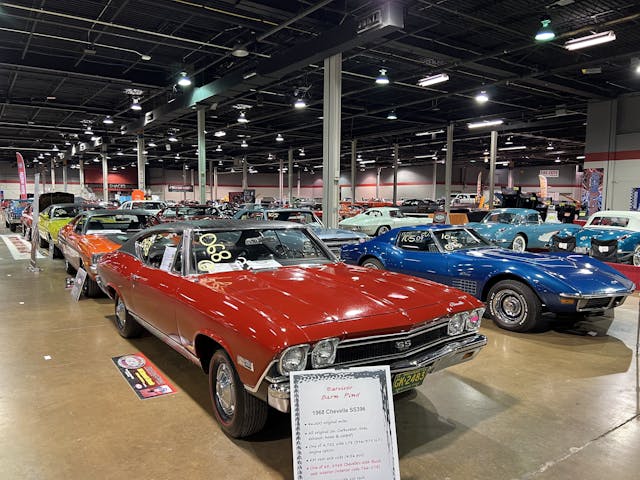
There’s a great opportunity to learn from the diversity of cars in attendance. Even the most common of cars, like this SS 396 with wheelcovers, may have a story behind it, like how it has Buick Skylark seats due to a UAW strike.

Now you’ve arrived at the most popular display at MCACN: Barn Finds and Hidden Gems. Organized by roving photographer Ryan Brutt, this assemblage of blemished vehicles may be lacking in condition, but they have a certain magic that all the rest of the original and restored cars lack. For example, check out that 1968 Ranchero GT. Recognize the paint scheme? It’s a Bill Stroppe car. Apparently it was at Bonneville powered by a Boss 429, but nothing else is known at the moment. Maybe you can help the owner fill in the blanks? And that Daytona is a real Hemi car that has been in storage for 45 years.

This 1960 Ford Galaxie Starliner was one of the most stylish cars from that year, and it also ushered in Ford’s commitment to NASCAR thanks to its sleek shape and the introduction of the high-performance 352 with 360 horsepower. This solid-lifter engine was only available with a three-speed on the column. That scoop you see is from a late-1960s Ford.

The 1964 Studebaker Lark received a handsome facelift from Milwaukee industrial designer Brooks Stevens. This Lark Daytona, which was found on Craigslist 20 years ago, has the R1 engine, which was the first step in Studebaker high performance. It put out 240 naturally aspirated horses, and the package also included rear-sway bar and radius rods. A Dana 44 with 3.54 gears are out back. All told, 69 Daytona hardtops were built with the R1. Dig the Halibrand magnesiums!
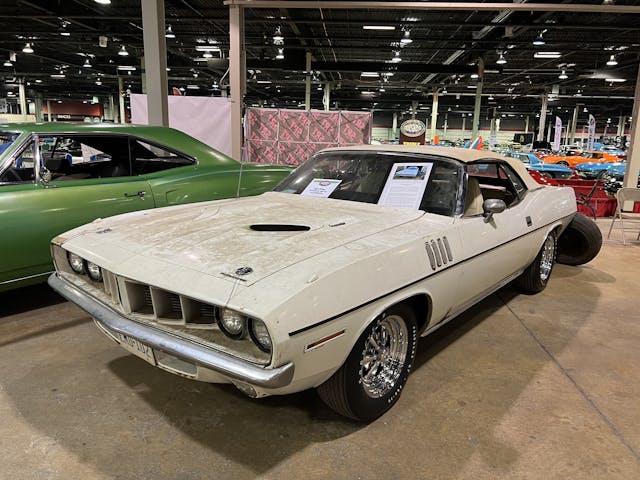
Even though only 374 1971 ‘Cuda ragtops were built, there are some that are still waiting to be discovered. This ‘Cuda 383 is even more interesting because it’s triple white, an unusual combination for any car that Boss Hoss isn’t driving.
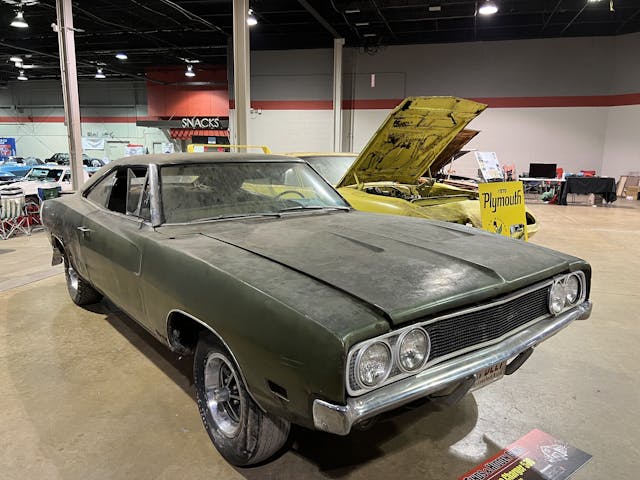
The 1969 Charger 500 was Dodge’s first NASCAR homologation special, the car that spurred the Torino Talladega and Cyclone Spoiler II for an all-out aero war. This car has the standard 440 like a basic R/T, though in early literature the 426 Hemi was going to be the only engine available.

The L72 was Chevrolet’s top street big-block, a 427 rated at 425 horses and the same one powering COPO Camaros. Only 546 were installed in full-size Chevys, but it’s unknown how many were installed in four-doors like this Impala sedan. Painted in Burnished Brown with Champagne painted top, it was ordered with F41 suspension, 3.73 gears with Positraction, and new-for-1969 TH400 (previously, all L72s required manual transmission), among other options. The original Virginia owner put on almost 65,000 miles in two years, but a collision with a horse put the Impala in a barn until recently.

You may have seen a number of AAR’Cudas in Part I of this tour, but none of them have the bad stance of this one.
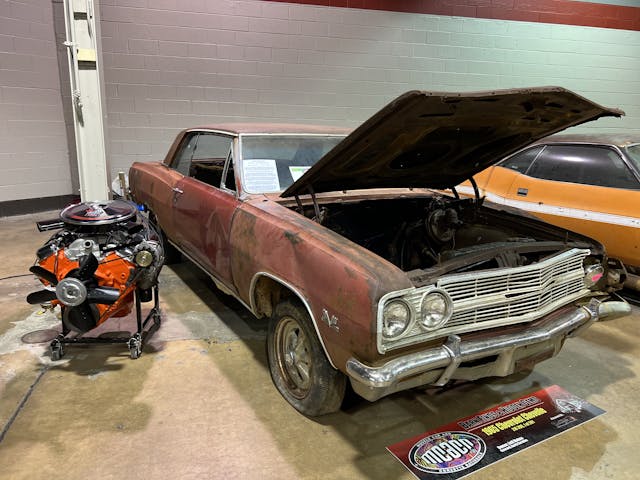
If you want to find a 1965 Chevelle worth more than an equivalent 396 Corvette, look no further. This Z16 Chevelle was left in an Oklahoma junkyard in 1976, but the proprietor knew something was special about this car and removed the Z16-specific pieces for storage. Several years later, a restoration was undertaken, but the body sat on dirt for almost 40 years till it was saved two years ago.


This black 1970 Cutlass Supreme has the “Y79” SX package, which included a 455, automatic, dual exhaust (with those nifty trumpets like on the 4-4-2), and cruising gears—think of it as a personal-luxury highway cruiser. There was an available W32 engine available, which gave the SX the same 365-horse engine as the standard 4-4-2. Less than 800 convertibles were built, with an unknown number of W32s, but it may be equally as rare as this 4-4-2 W30 convertible, of which 264 were built with the W30 package. Of those, 96 had a four-speed, so this car is at the top of the totem pole for Oldsmobiles. But, like the ‘Cuda above, it’s an unusual triple white car, plus the red stripes are a nice change from the usual black or gold stripes.


You may have noticed in the news how Hertz is experiencing some pains, like many companies, but in the 1960s Hertz Rent-A-Car was #1 without trying. Of course, Hertz had a program where you could rent one of 1000 Shelby GT350s (rebadged as GT350-H) and experience the vehicle that had owned the Sports Car Club of America National Championship. But that wasn’t the only fancy car that Hertz offered to enthusiasts during the era—there also was a handful of 1968 Cougar XR7-Gs (188 out of the 622 built) earmarked for rental. Cougar folks like to think of the XR7-G as a Shelby-ized Cougar, as once they left the factory, they were shipped to A.O. Smith.
The Shelby contractor (1968–70, not to mention the fabricator of Corvettes through 1966), located approximately 130 miles west of Detroit, performed the “G” conversion which included: fiberglass hood scoop, emblems, fog lamps, side-view mirrors, and Rader aluminum wheels, although the latter were soon recalled. Finished cars were then sent back to ASC in Detroit for sunroof conversion before being distributed through Ford’s channels. The “G”, of course, was a reference to Dan Gurney, who was racing for Mercury.

We’ll close this tour of MCACN with some Corvettes. Lest we forget, MCACN used to be a Chevy and Corvette show, you’ll find several displays of some of the best Corvettes in the country. Sometimes it’s amazing to see how many original Corvettes there really are out there.


If you’re a fan of 1967s (like everybody else), you’re bound to find one that you really like. What’s noticeable is how the design has aged so well, coming into the world when the Beatles were just picking up steam in the States and exiting after Sgt. Pepper made an impact.

And it’s not just big-blocks that receive the love, as evidenced by this 1969 Stingray with a 350. Next to it is a 1970 with an LS5 454 with 390 horses. Interestingly, that was the top horsepower for the Corvette that year—yes, the Corvette never received the LS6 till 1971, and it went missing for the Chevelle that year. Funny stuff!
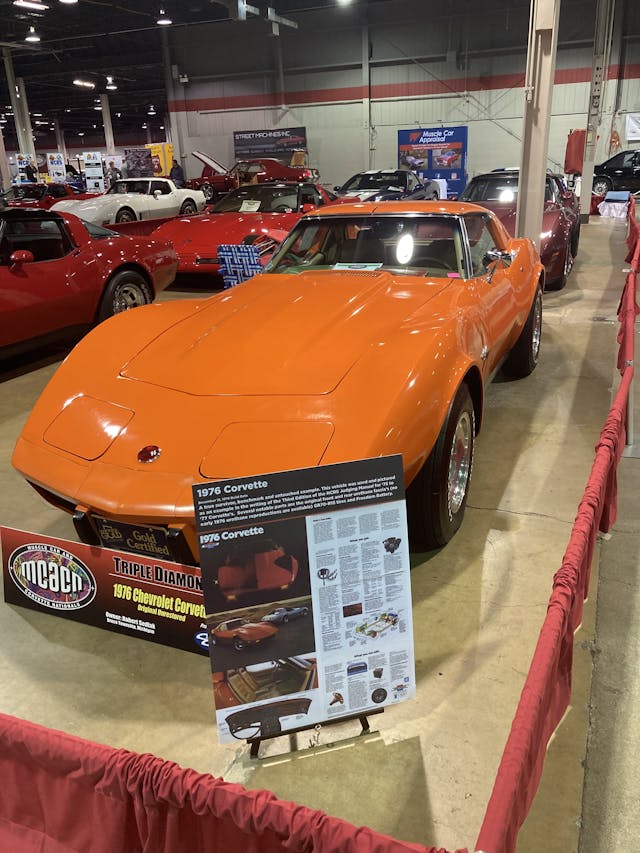
Even Malaise-era Corvettes get their due like this original, unrestored 1976. No, no red-headed stepchild among Corvette folks.

